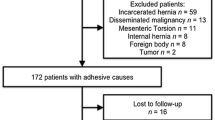Abstract
The aim of this study was the detection of criteria that support the indication for laparoscopic adhesiolysis in patients presenting with unspecific symptoms. A prospective analysis investigates the value of laparoscopic adhesiolysis in patients with chronic abdominal pain after exclusion of other pathologic findings; 58 consecutive patients were followed after laparoscopic adhesiolysis. Endpoints of investigation were extent of adhesions, complications, postoperative hospitalization, and postoperative quality of life. A comparison was drawn to patients following laparoscopic cholecystectomy, laparoscopic cholecystectomy plus adhesiolysis, and conventional cholecystectomy.
The results showed that major complications occurred in 10% of cases. In 45% of patients we found a complete remission, in 35% a substantial improvement, and in 20% a persistence of complaints. In a correlation between the preoperative complaints and the extent of adhesions we found small adhesions to cause recurrent abdominal pain without other symptoms while large adhesions produce recurrent abdominal pain in combination with symptoms indicative of intermittent bowel obstruction.
Finally, the results of this study indicate a certain “ideal constellation” for an enduring successful adhesiolysis per laparoscopy: it is the subjective complaint of recurrent abdominal pain with a localized and reproducible punctum maximum in combination with a circumscribed area of adhesions at that site.
Similar content being viewed by others
References
Eypasch E, Spangenberger W, Williams JI, Ure B, Neugebauer W, Wood-Dauphinee S, Troidl H (1992) Frühe postoperative Verbesserung der Lebensqualität nach laparoskopischer Cholecystektomie. In: Häring R (ed) Diagnostik und Therapie des Gallensteinleidens im Wandel der Zeit. Blackwell, Berlin, pp 481–491
Fervers C (1933) Die Laparoskopie mit dem Cystoskop. Ein Beitrag zur Vereinfachung der Technik und zur endoskopischen Strangdurchtrennung in der Bauchhöhle. Med Klin Chir 178: 288
Fuchs KH, Freys SM, Heimbucher J, Thiede A (1992) Laparoskopische Cholecystektomie—lohnt sich die laparoskopische Technik in “schwierigen” Fällen? Chirurg 63: 296–304
Meiser G, Waclawiczek HW, Heinerman M, Boeckl O (1990) Der intermittierende inkomplette Dünndarmileus—sonographische Diagnostik und Trendbeobachtung. Chirurg 61: 651–656
Riedel HH, Lehmann-Willenbrock E, Mecke H, Semm K (1989) The frequency distribution of various pelviscopic (laparoscopic) operations, including complications rates—statistics of the Federal Republic of Germany in the years 1983–1985. Zentralbl Gynakol 111: 78–91
Semm K (1984) Operationslehre für endoskopische Abdominalchirurgie. Schattauer, Stuttgart
Semm K (1988) Sichtkontrollierte Peritoneumperforation zur operativen Pelviskopie. Geburtshilfe Frauenheilkd 48: 436–439
Tavmergen EN, Mecke H, Semm K (1990) Häufigkeit intraabdomineller Adhäsionen nach Pelviskopie und Laparotomie. Zentralb Gynakol 112: 1163–1169
Troidl H, Spangenberger W, Dietrich A, Neugebauer F (1991) Laparoskopische Cholecystektomie. Erste Erfahrungen und Ergebnisse bei 300 Operationen: eine prospektive Beobachtungsstudie. Chirurg 62: 257–265
Author information
Authors and Affiliations
Rights and permissions
About this article
Cite this article
Freys, S.M., Fuchs, K.H., Heimbucher, J. et al. Laparoscopic adhesiolysis. Surg Endosc 8, 1202–1207 (1994). https://doi.org/10.1007/BF00591051
Received:
Accepted:
Issue Date:
DOI: https://doi.org/10.1007/BF00591051




